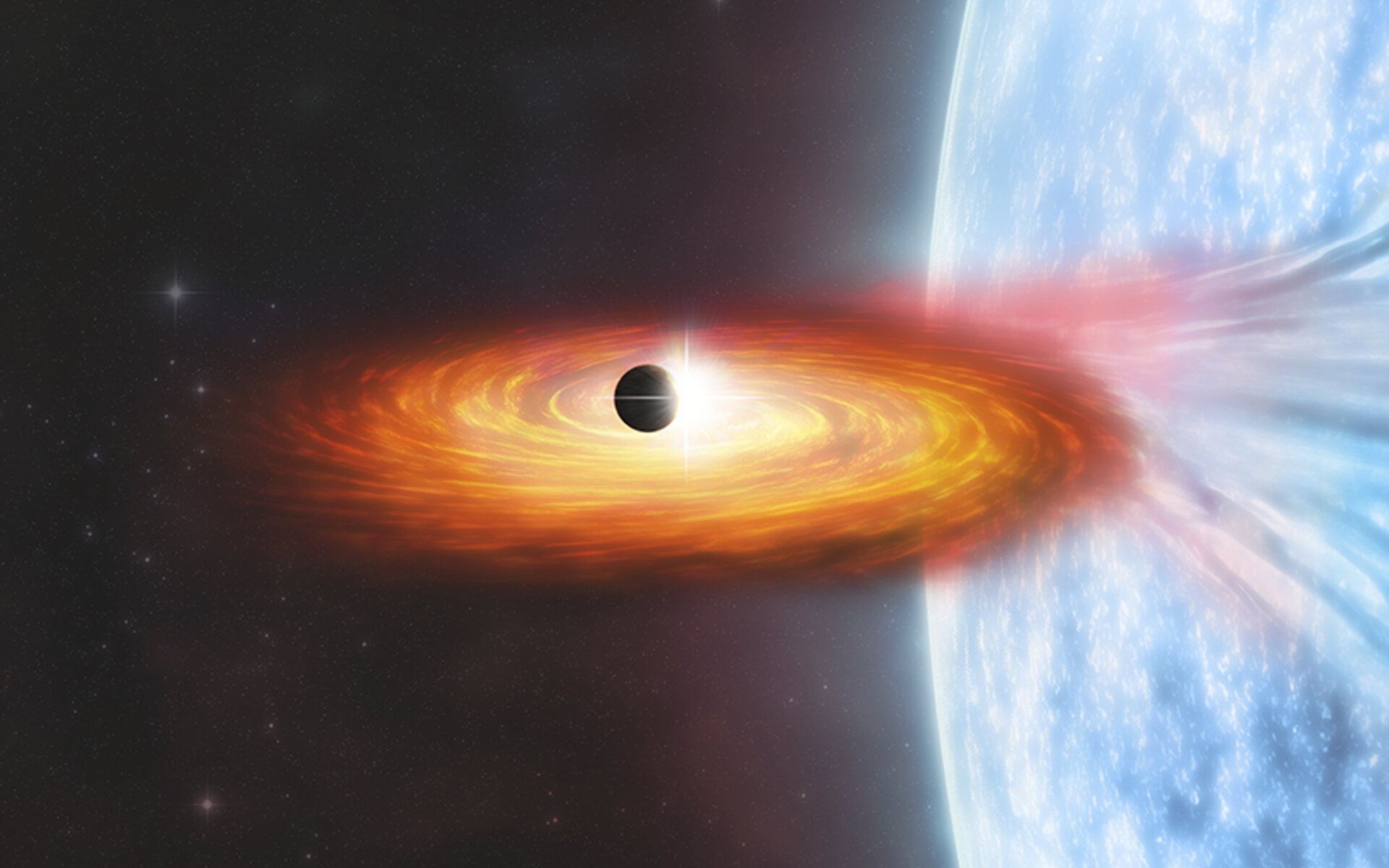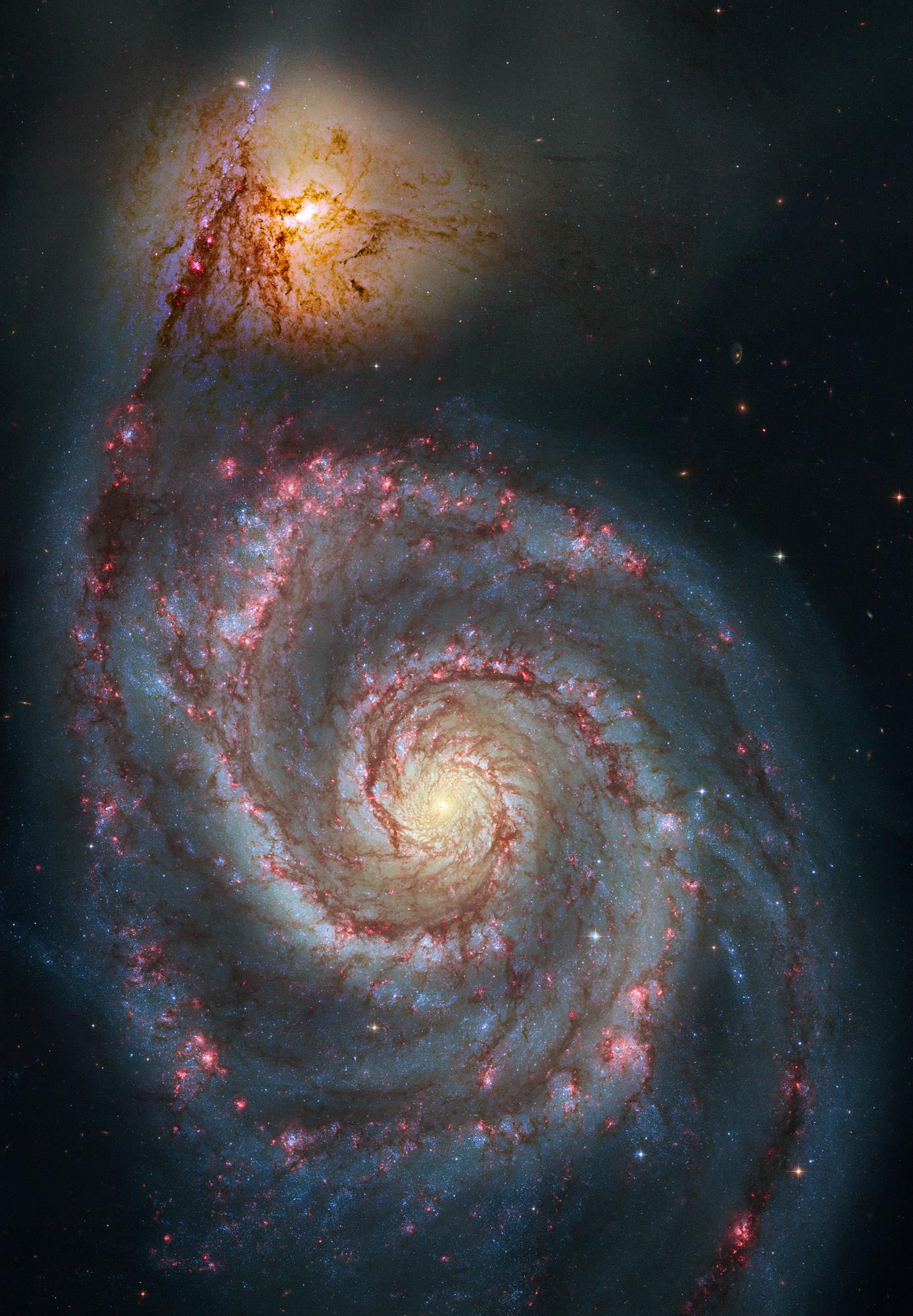Understanding how star-forming works at a galactic scale is challenging in our Milky Way. While we have a general understanding of the layout of our galaxy, we can’t see all of the details head-on like we would want to if we were exploring a single galaxy for details of star formation. Luckily, we have a pretty good view of the entirety of one of the most famous galaxies in all of astronomy – M51, the Whirlpool Galaxy. Now, a team of researchers from the Max Planck Institute for Astronomy has completed a survey of molecules throughout the galaxy and developed a map of potential star-forming regions.
Continue reading “Astronomers Find the Birthplaces of Stars in the Whirlpool Galaxy”The Whirlpool Galaxy, Seen by JWST
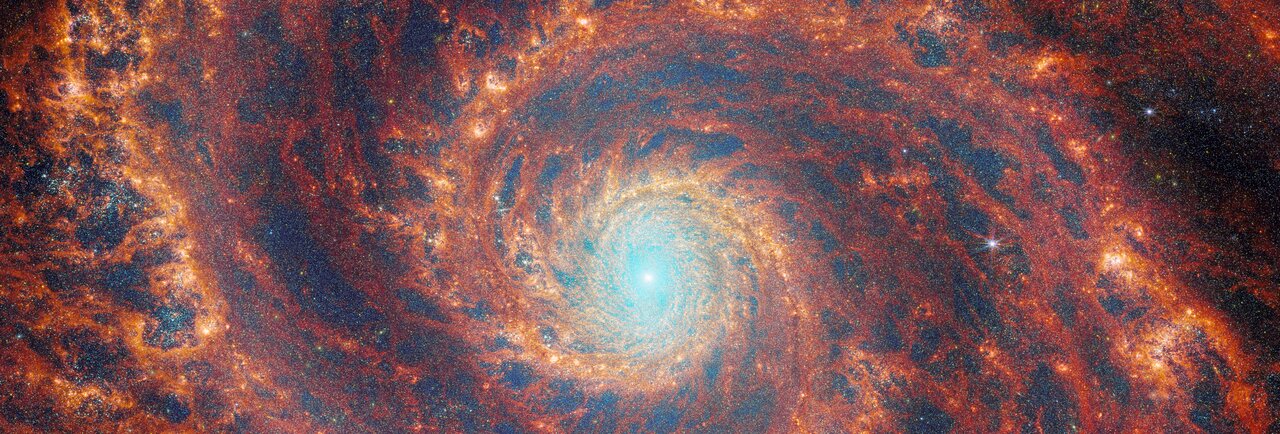
The Whirlpool Galaxy, aka M51, is one of the most well-known objects in the night sky. It’s close enough and prominent in the northern sky that amateur astronomers have shared stunning pictures of it for decades. But you’ve never seen anything like this: M51 as seen by the James Webb Space Telescope (JWST). This image contains data from the telescope’s NIRCam and MIRI instruments, which shows incredible detail and reveals hidden features among the spiral arms.
Continue reading “The Whirlpool Galaxy, Seen by JWST”Astronomers Might Have Found a Planet in Another Galaxy
Not that long ago,, astronomers weren’t sure that exoplanets even existed. Now we know that there are thousands of them and that most stars probably harbour exoplanets. There could be hundreds of billions of exoplanets in the Milky Way, by some estimates. So there’s no reason to think that stars in other galaxies don’t host planets.
But to find one of those planets in another galaxy? That is a significant scientific achievement.
Continue reading “Astronomers Might Have Found a Planet in Another Galaxy”The Magnetic Fields Swirling Within the Whirlpool Galaxy
Messier objects are some of the most imaged objects in the universe. In part that’s because many of them are so visibly appealing. A good example of that is the Whirlpool galaxy, M51, which recently received an even more dramatic visual representation with a new photo released by NASA. In it, the magnetic fields that are holding the galaxy together and tearing it apart at the same time are clearly visible. And it is even more stunning to look at.
Continue reading “The Magnetic Fields Swirling Within the Whirlpool Galaxy”Messier 51 – the Whirlpool Galaxy
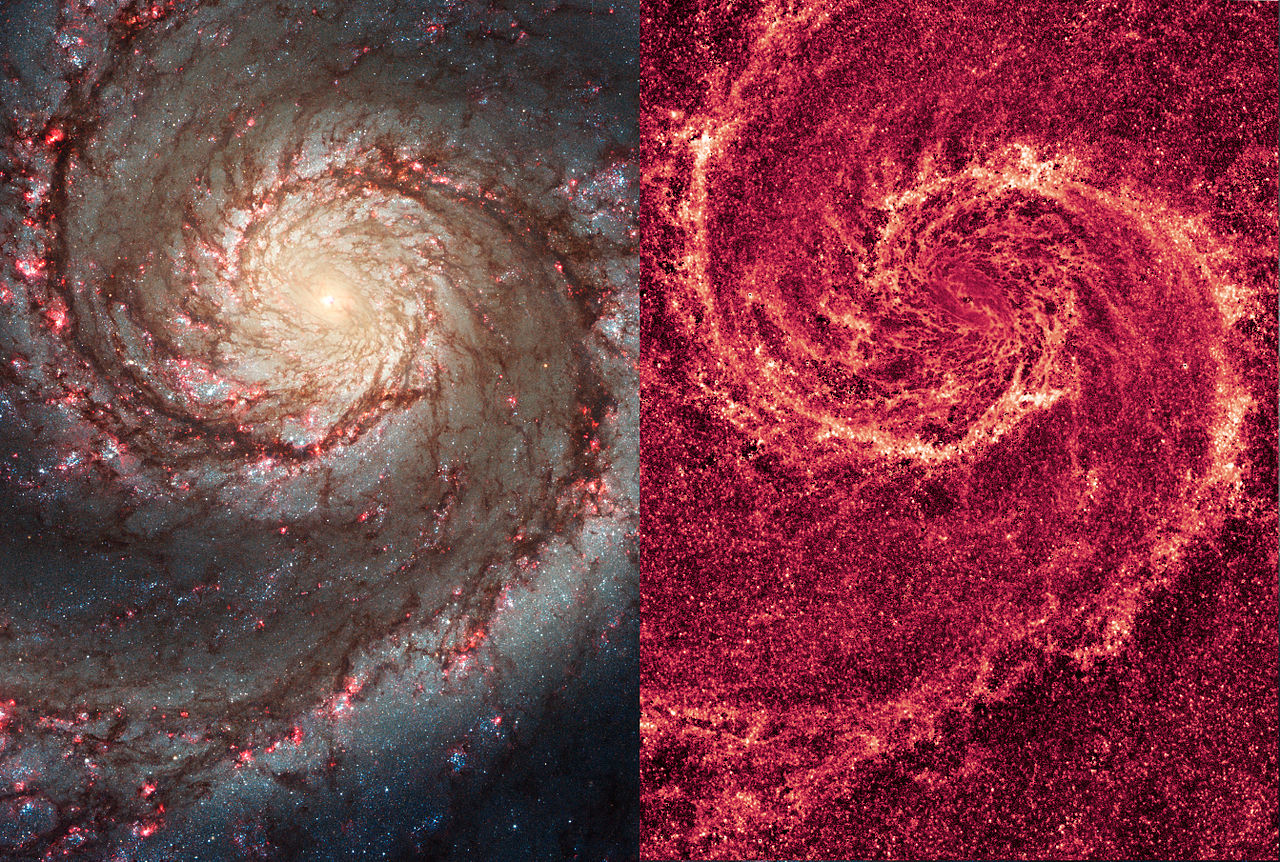
Welcome back to Messier Monday! In our ongoing tribute to the great Tammy Plotner, we take a look at that swirling, starry customer, the Whirlpool Galaxy!
During the 18th century, famed French astronomer Charles Messier noted the presence of several “nebulous objects” in the night sky. Having originally mistaken them for comets, he began compiling a list of them so that others would not make the same mistake he did. In time, this list (known as the Messier Catalog) would come to include 100 of the most fabulous objects in the night sky.
One of these is the spiral galaxy located in the constellation Canes Venatici known as the Whirlpool Galaxy (aka. Messier 51). Located between 19 and 27 million light-years from the Milky Way, this deep sky object was the very first to be classified as a spiral galaxy. It is also one of the best known galaxies among amateur astronomers, and is easily observable using binoculars and small telescopes.
Description:
Located some 37 million light years away, M51 is the largest member of a small group of galaxies, which also houses M63 and a number of fainter galaxies. To this time, the exact distance of this group isn’t properly known… Even when a 2005 supernova event should have helped astronomers to correctly calculate! As K. Takats stated in a study:
“The distance to the Whirlpool galaxy (M51, NGC 5194) is estimated using published photometry and spectroscopy of the Type II-P supernova SN 2005cs. Both the expanding photosphere method (EPM) and the standard candle method (SCM), suitable for SNe II-P, were applied. The average distance (7.1 +/- 1.2 Mpc) is in good agreement with earlier surface brightness fluctuation and planetary nebulae luminosity function based distances, but slightly longer than the distance obtained by Baron et al. for SN 1994I via the spectral fitting expanding atmosphere method. Since SN 2005cs exhibited low expansion velocity during the plateau phase, similarly to SN 1999br, the constants of SCM were recalibrated including the data of SN 2005cs as well. The new relation is better constrained in the low-velocity regime, that may result in better distance estimates for such SNe.”
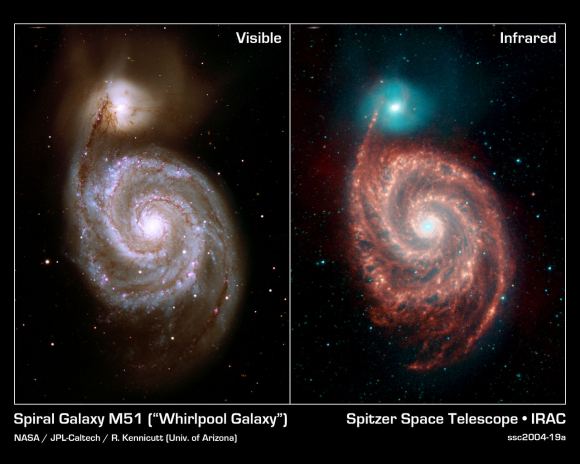
Of course, one of the most outstanding features of the Whirlpool Galaxy is its beautiful spiral structure – perhaps result of the close interaction between it and its companion galaxy NGC 5195? As S. Beckwith,
“This sharpest-ever image of the Whirlpool Galaxy, taken in January 2005 with the Advanced Camera for Surveys aboard NASA’s Hubble Space Telescope, illustrates a spiral galaxy’s grand design, from its curving spiral arms, where young stars reside, to its yellowish central core, a home of older stars. At first glance, the compact galaxy appears to be tugging on the arm. Hubble’s clear view, however, shows that NGC 5195 is passing behind the Whirlpool. The small galaxy has been gliding past the Whirlpool for hundreds of millions of years. As NGC 5195 drifts by, its gravitational muscle pumps up waves within the Whirlpool’s pancake-shaped disk. The waves are like ripples in a pond generated when a rock is thrown in the water. When the waves pass through orbiting gas clouds within the disk, they squeeze the gaseous material along each arm’s inner edge. The dark dusty material looks like gathering storm clouds. These dense clouds collapse, creating a wake of star birth, as seen in the bright pink star-forming regions. The largest stars eventually sweep away the dusty cocoons with a torrent of radiation, hurricane-like stellar winds, and shock waves from supernova blasts. Bright blue star clusters emerge from the mayhem, illuminating the Whirlpool’s arms like city streetlights.”
But there were more surprises just waiting to be found – like a black hole, surrounded by a ring of dust. What makes it even more odd is a secondary ring crosses the primary ring on a different axis, a phenomenon that is contrary to expectations and a pair of ionization cones extend from the axis of the main dust ring. As H. Ford,
“This image of the core of the nearby spiral galaxy M51, taken with the Wide Field Planetary camera (in PC mode) on NASA’s Hubble Space Telescope, shows a striking , dark “X” silhouetted across the galaxy’s nucleus. The “X” is due to absorption by dust and marks the exact position of a black hole which may have a mass equivalent to one-million stars like the sun. The darkest bar may be an edge-on dust ring which is 100 light-years in diameter. The edge-on torus not only hides the black hole and accretion disk from being viewed directly from earth, but also determines the axis of a jet of high-speed plasma and confines radiation from the accretion disk to a pair of oppositely directed cones of light, which ionize gas caught in their beam. The second bar of the “X” could be a second disk seen edge on, or possibly rotating gas and dust in MS1 intersecting with the jets and ionization cones.”
History of Observation:
The Whirlpool Galaxy was first discovered by Charles Messier on October 13th, 1773 and re-observed again for his records on January 11th, 1774. As he wrote of his discovery in his notes:
“Very faint nebula, without stars, near the eye of the Northern Greyhound [hunting dog], below the star Eta of 2nd magnitude of the tail of Ursa Major: M. Messier discovered this nebula on October 13, 1773, while he was watching the comet visible at that time. One cannot see this nebula without difficulties with an ordinary telescope of 3.5 foot: Near it is a star of 8th magnitude. M. Messier reported its position on the Chart of the Comet observed in 1773 & 1774. It is double, each has a bright center, which are separated 4’35”. The two “atmospheres” touch each other, the one is even fainter than the other.”
It would be his faithful friend and assistant, Pierre Mechain who would discover NGC 5195 on March 21st, 1781. Even though it would be many, many years before it was proven that galaxies were indeed independent systems, historic astronomers were much, much sharper than we gave them credit for. Sir William Herschel would observe M51 many times, but it would be his son John who would be the very first to comment on M51’s scheme:
“This very singular object is thus described by Messier: – “Nebuleuse sans etoiles.” “On ne peut la voir que difficilement avec une lunette ordinaire de 3 1/2 pieds.” “Elle est double, ayant chacune un centre brillant eloigne l’un de l’autre de 4′ 35″. Les deux atmospheres se touchent.” By this description it is evident that the peculiar phenomena of the nebulous ring which encircles the central nucleus had escaped his observation, as might have been expected from the inferior light of his telescopes. My Father describes it in his observations of Messier’s nebulae as a bright round nebula, surrounded by a halo or glory at a distance from it, and accompanied by a companion; but I do not find that the partial subdivision of the ring into two branches throughout its south following limb was noticed by him. This is, however, one of its most remarkable and interesting features. Supposing it to consist of stars, the appearance it would present to a spectator placed on a planet attendant on one of them eccentrically situated towards the north preceding quarter of the central mass, would be exactly similar to that of our Milky Way, traversing in a manner precisely analogous the firmament of large stars, into which the central cluster would be seen projected, and (owing to its distance) appearing, like it, to consist of stars much smaller than those in other parts of the heavens. Can it, then, be that we have here a brother-system bearing a real physical resemblance and strong analogy of structure to our own? Were it not for the subdivision of the ring, the most obvious analogy would be that of the system of Saturn, and the idea of Laplace respecting the formation of that system would be powerfully recalled by this object. But it is evident that all idea of symmetry caused by rotation on an axis must be relinquished, when we consider that the elliptic form of the inner subdivided portion indicates with extreme probability an elevation of that portion above the plane of the rest, so that the real form must be that of a ring split through half its circumference, and having the split portions set asunder at an angle of about 45 deg each to the plane of the other.”
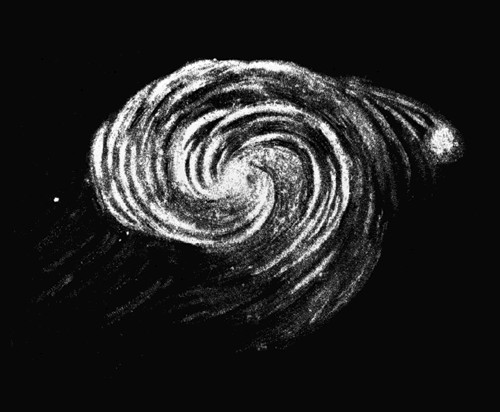
As with other Messier Objects, Admiral Smyth also had some insightful and poetic observations to add. As he wrote of this galaxy in September of 1836:
“We have then an object presenting an amazing display of the uncontrollable energies of the Omnipotence, the contemplation of which compels reason and admiration to yield to awe. On the outermost verge of telescopic reach we perceive a stellar universe similar to that to which we belong, whose vast amplitudes no doubt are peopled with countless numbers of percipient beings; for those beautiful orbs cannot be considered as mere masses of inert matter.
And it is interesting to know that, if there be intelligent existence, an astronomer gazing at our distant universe, will see it, with a good telescope, precisely under the lateral aspect which theirs presents to us. But after all what do we see? Both that wonderful universe, our own, and all which optical assistance has revealed to us, may be only the outliers of a cluster immensely more numerous.
The millions of suns we perceive cannot comprise the Creator’s Universe. There are no bounds to infinitude; and the boldest views of the elder Herschel only placed us as commanding a ken whose radius is some 35,000 times longer than the distance of Sirius from us. Well might the dying Laplace explain: “That which we know is little; that which we know not is immense.”
Lord Rosse would continue on in 1844 with his 6-feet (72-inch) aperture, 53-ft FL “Leviathan” telescope, but he was a man of fewer words.
“The greater part of the observations were made when the eye was affected by lamp-light, which made it difficult to estimate correctly the centre of the nucleus; it was of importance that no time should be unnecessarily spent, and after the lamp had been used a new measure was taken, as it was judged that the object was sufficiently seen. With the brighter stars this would frequently happen before the nucleus was well defined, as all impediments to vision seem to affect nebulae much more than stars the light of which would be estimated as of the same intensity. In the foregoing list the greatest discrepancies are in the measures of bright objects, and this is probably the proper account of it. No stars have been inserted in the sketch which are not in the table of the measurements. The general appearance of the object would have been better given if the minute stars had been put in from the eye-sketch, but it would have created confusion.”
May the stars from this distant island universe fill your eyes!
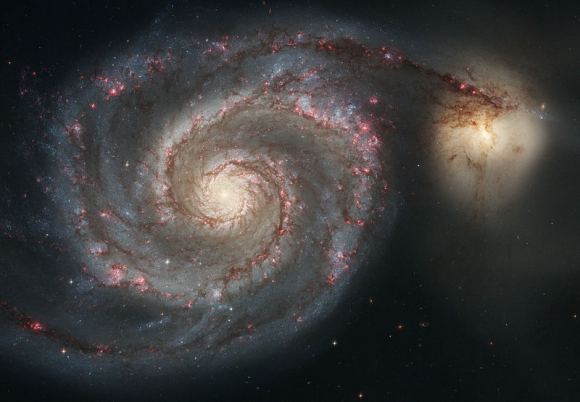
Locating Messier 51:
Locating M51 isn’t too hard if you have dark skies, but this particular galaxy is very difficult where light pollution of moonlight is present. To find it, start with Eta UM, the star at the handle of the Big Dipper. In the finderscope or binoculars, you’ll clearly see 24 UM to the southwest. Now, center your optics there and move slowly southwest towards Cor Caroli (Alpha CVn) and you’ll find it!
In locations where skies are clear and dark, it is easy to see spiral structure in even small telescopes, or to make out the galaxy in binoculars – but even a change in sky conditions can hide it from a good location. Rich field telescopes with fast focal lengths to an outstanding job on this galaxy and companion and you may be able to make out the nucleus of both galaxies on a good night from even a bad location.
Object Name: Messier 51
Alternative Designations: M51, NGC 5194, The Whirlpool Galaxy
Object Type: Type Sc Galaxy
Constellation: Canes Venatici
Right Ascension: 13 : 29.9 (h:m)
Declination: +47 : 12 (deg:m)
Distance: 37000 (kly)
Visual Brightness: 8.4 (mag)
Apparent Dimension: 11×7 (arc min)
We have written many interesting articles about Messier Objects here at Universe Today. Here’s Tammy Plotner’s Introduction to the Messier Objects, , M1 – The Crab Nebula, M8 – The Lagoon Nebula, and David Dickison’s articles on the 2013 and 2014 Messier Marathons.
Be to sure to check out our complete Messier Catalog. And for more information, check out the SEDS Messier Database.
Sources:
Carnival of Space #357
Welcome, come in to the 357th Carnival of Space! The carnival is a community of space science and astronomy writers and bloggers, who submit their best work each week for your benefit. I’m Susie Murph, part of the team at Universe Today and now, on to this week’s stories!
We’re going to start off with a double blast from the past, courtesy of CosmoQuest! This week, they’re featuring Stuart Robbins’s blog post from January 13, 2012, titled “Perspective on the Apollo 15 Landing Site.” He explores the region of the Moon that is the current home of the MoonMappers images that YOU are still mapping and exploring today – the Apollo 15 landing site area. It’s a neat place and we can study a lot of things there. Due to a quirk of optics and angles, you can even imagine you’re flying towards it.
Next, we stay with Cosmoquest’s Moon Mappers as they highlight the interesting discovery that the groundbreaking Soviet Lunakhod 2 lunar rover traveled farther than earlier estimated on it’s mission in 1972. Visit MoonMappers at Cosmoquest for more great stories!
Moving through history, we travel over to io9’s Space blog for a history of the American Space Shuttle disasters is a grim reminder of the danger of space travel. Just released is Major Malfunction, a documentary on the two Shuttle catastrophes. Major malfunction is an understatement for the destruction of Space Shuttle Challenger moments after launch in 1986, and the loss of Space Shuttle Columbia during re-entry in 2003.
Next at io9, we visit Mars to view the magnificent Draa, which are ancient landforms created from waves of sand. Check out the article and it’s images here.
We also have another article from io9, which new astronaut Reid Wiseman recounts his first adventurous days in space.
Now we’ll jump over for some gorgeous views from the Chandra X-Ray Observatory! One of their new images is a glorious view of the Whirlpool spiral galaxy which radiates with fantastic points of x-ray light. These image is breath-taking!
Want more gorgeous images? Visit Brownspaceman.com to see his discussion of the Tulip Nebula, which is a composite image which also maps the emissions from this incredible nebula.
Next, we head over to the Meridani Journalfor coverage of a major find in the search for exoplanets. A new world which is more than twice as large as Earth and about 17 times heavier has been discovered, a sort of “mega-Earth” as some have referred to it.
The NextBigFuture Blog lives up to it’s name by bringing us two interesting stories from Elon Musk and his company SpaceX. First, he points out that the key is reusability. Musk said the crewed Dragon is designed to land softly back on Earth and be rapidly turned around for another flight — possibly on the same day. Spacex is aiming for 10 flights without any significant refurbishment for the Dragon v2. The thing that will have to be refurbished is the main heat shield. Further improved heat shield materials [later versions of PICA-X] would mean Spacex could aim for 100 reusable flights.
We then head over to the Urban Astronomer, where recent observations of a very near pair of brown dwarf objects has led to something new: We’re watching the weather on stars themselves!
Finally, we return to Universe Today for some interesting potential missions. First, the B612 Foundation’s privately-funded Sentinel mission, once launched and placed in orbit around the Sun in 2018, will hunt for near-Earth asteroids down to about 140 meters in size using the most advanced infrared imaging technology, without government red tape to hamper the mission. Next, the NASA Innovative Advanced Concepts office announced a dozen far-flung drawing-board proposals that have received $100,000 in Phase 1 funding for the next 9-12 months, one of which is a balloon for exploring Titan. We’re looking forward to hearing about these projects and many others in the coming years.
That’s it for this week’s Carnival! See you all next time!
And if you’re interested in looking back, here’s an archive to all the past Carnivals of Space. If you’ve got a space-related blog, you should really join the carnival. Just email an entry to [email protected], and the next host will link to it. It will help get awareness out there about your writing, help you meet others in the space community – and community is what blogging is all about. And if you really want to help out, sign up to be a host. Send an email to the above address.
Amazing New X-Ray Image of the Whirlpool Galaxy Shows it is Dotted with Black Holes
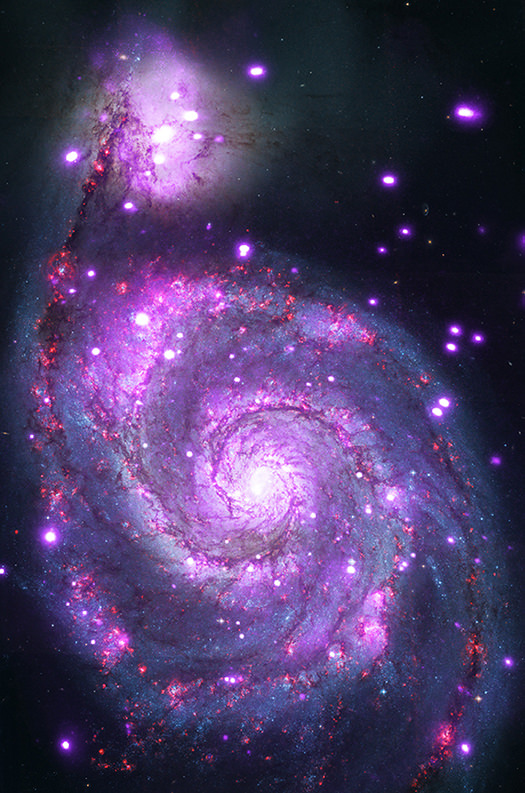
In any galaxy there are hundreds of X-ray binaries: systems consisting of a black hole capturing and heating material from a relatively low-mass orbiting companion star. But high-mass X-ray binaries — systems consisting of a black hole and an extremely high-mass companion star — are hard to come by. In the Milky Way there’s only one: Cygnus X-1. But 30 million light-years away in the Whirlpool galaxy, M51, there are a full 10 high-mass X-ray binaries.
Nearly a million seconds of observing time with NASA’s Chandra X-ray Observatory has revealed these specks. “This is the deepest, high-resolution exposure of the full disk of any spiral galaxy that’s ever been taken in the X-ray,” said Roy Kilgard, from Wesleyan University, at a talk presented at the American Astronomical Society meeting today in Boston. “It’s a remarkably rich data set.”
Within the image there are 450 X-ray points of light, 10 of which are likely X-ray binaries.
The Whilpool galaxy is thought to have so many X-ray binaries because it’s in the process of colliding with a smaller companion galaxy. This interaction triggers waves of star formation, creating new stars at a rate seven times faster than the Milky Way and supernova deaths at a rate 10-100 times faster. The more-massive stars simply race through their evolution in a few million years and collapse to form neutron stars or black holes quickly.
“In this image, there’s a very strong correlation between the fuzzy purple stuff, which is hot gas in the X-ray, and the fuzzy red stuff, which is hydrogen gas in the optical,” said Kilgard. “Both of these are tracing the star formation very actively. You can see it really enhanced in the northern arm that approaches the companion galaxy.”
Eight of the 10 X-ray binaries are located close to star forming regions.
Chandra is providing astronomers with an in depth look at a class of objects that has only one example in the Milky Way.
“We’re catching them at a short window in their evolutionary cycle,” said Kilgard. “The massive star that formed the black hole has died, and the massive star that is accreting material onto the black hole has not yet died. The window at which these objects are X-ray bright is really short. It’s maybe only tens of thousands of years.”
Additional information available on the Chandra website.
Virtual Star Party – May 4, 2014: It’s Galaxy Season!
Hosts: Fraser Cain and Scott Lewis
Astronomers: Gary Gonella, Andrew Dumbleton, Stuart Foreman, David Dickinson, Shahrin Ahmad and special guest Henna Khan from Bombay, India
Tonight’s Views:
the Moon’s surface
M44 Beehive Cluster
Neutron Star B224 from HST
All-Sky View
Mars with ice caps and Hellas Basin visible
Comet C/2012 K1 PanSTARRS
Stuart demonstrating how to work with software to process images
M51a Whirlpool Galaxy
M53 Globular Cluster
Rosette Nebula – NGC 2237, 2238, 2239 and 2246
Saturn
Horsehead Nebula (Barnard 33 in emission nebula IC 434) and Flame Nebula (NGC 2024) with a satellite trail
NGC 5139 Omega Centauri
M42 Orion Nebula
M63 Sunflower Galaxy
NGC 7635 Bubble Nebula
Large and Small Magellanic Clouds
We hold the Virtual Star Party every Sunday night as a live Google+ Hangout on Air. We begin the show when it gets dark on the West Coast. If you want to get a notification, make sure you circle the Virtual Star Party on Google+. You can watch on our YouTube channel or here on Universe Today.
Mapping Molecular Clouds Changes Astronomers Outlook On Starbirth

It didn’t happen overnight. By studying the properties of giant molecular clouds in the Whirlpool Galaxy for several years with the millimeter telescopes of IRAM, the Institut de Radioastronomie Millimétrique, astronomers have been given a whole, new look at star formation. Encompassing 1,500 maps of molecular clouds, this new research has found these building blocks of future suns to be encased in a sort of molecular hydrogen mist. This ethereal mixture appears to be far denser than speculated and is found throughout the galactic disc. What’s more, it would appear the pressure created by the molecular fog is a critical factor in determining whether or not stars are able to form within the clouds.
Stars form in the molecular clouds housed within all galaxies. These formations are vast areas of hydrogen molecules with masses which total from a thousand to several million times that of the Sun. When an area of the cloud folds under the weight of its own gravity, it collapses. Pressure and temperature rise and nuclear fusion begins. A star is born.
This exciting new research is changing the way astronomers think about starbirth regions. Study leader Eva Schinnerer (Max Planck Institute for Astronomy) explains: “Over the past four years, we have created the most complete map yet of giant molecular clouds in another spiral galaxy similar to our own Milky Way, reconstructing the amounts of hydrogen molecules and correlating them with the presence of new or older stars. The picture that is emerging is quite different from what astronomers thought these clouds should be like.” The survey, known as PAWS, targeted the Whirlpool galaxy, also known as M51, at a distance of about 23 million light-years in the constellation Canes Venatici – the Hunting Dogs.
Annie Hughes, a post-doctoral researcher at MPIA involved in the study, says: “We used to think of giant molecular clouds as solitary objects, drifting within the surrounding interstellar medium of rarified gas in isolated splendor; the main repository of a galaxy’s supply of hydrogen molecules. But our study shows that 50% of the hydrogen is outside the clouds, in a diffuse, disk-shaped hydrogen fog permeating the galaxy!”
Not only does the enveloping gas play a critical part in star formation, but galaxy structure does as well. One galactic feature in particular is key – spiral arm structure. They sweep slowly around the core area like hands on a clock and are more populated with stars than the remainder of the galactic disk. Sharon Meidt, another MPIA post-doctoral researcher involved in the study, says: “These clouds are definitely not isolated. On the contrary, interactions between clouds, fog, and overall galactic structure appear to hold the key to whether or not a cloud will form new stars. When the molecular fog moves relative to the galaxy’s spiral arms, the pressure it exerts on any clouds within is reduced, in line with a physical law known as Bernoulli’s principle. Clouds feeling this reduced pressure are unlikely to form new stars. According to the press release, Bernoulli’s law is also thought to be responsible for part of the well-known shower-curtain effect: shower curtains blowing inward when one takes a hot shower, another display of reduced pressure.
Jerome Pety of the Institut de Radioastronomie Millimétrique (IRAM), which operates the telescopes used for the new observations, says: “It’s good to see our telescopes live up to their full potential. A study that needed such extensive observation time, and required both an interferometer to discern vital details and our 30 m antenna to put those details into a larger context, would not have been possible at any other observatory.”
Schinnerer concludes: “So far, the Whirlpool galaxy is one example which we have studied in depth. Next, we need to check that what we have found also applies to other galaxies. For our next steps, we hope to profit from both the extension NOEMA of the compound telescope on the Plateau de Bure and from the newly opened compound telescope ALMA in Chile, which will allow in-depth studies of more distant spiral galaxies.”
Original Story Source: Max Planck Institute for Astronomy News Release.
Supernova Discovered in M51 The Whirlpool Galaxy
A new supernova (exploding star) has been discovered in the famous Whirlpool Galaxy, M51.
M51, The Whirlpool galaxy is a galaxy found in the constellation of Canes Venatici, very near the star Alkaid in the handle of the saucepan asterism of the big dipper. Easily found with binoculars or a small telescope.
The discovery was made on June 2nd by French astronomers and the supernova is reported to be around magnitude 14. More information (In French) can be found here or translated version here.
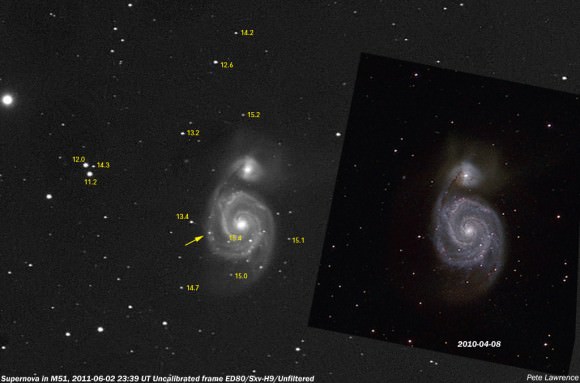
The supernova will be quite tricky to spot visually and you may need a good sized dobsonian or similar telescope to spot it, but it will be a easy target for those interested in astro imaging.
The whirlpool galaxy was the first galaxy discovered with a spiral structure and is one of the most recognisable and famous objects in the sky.


